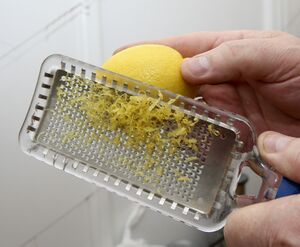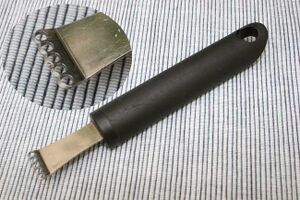Zester: Difference between revisions
(color) |
No edit summary |
||
| Line 14: | Line 14: | ||
'''Zest''', also known as '''citrus peel''' (technical name ''flavedo''), is a food ingredient that is prepared by scraping or cutting from the outer, colourful skin of [[citrus fruits]] such as [[lemon]], [[orange]], [[citron]], and [[lime]]. Zest is used to add flavour ("zest") to foods. | '''Zest''', also known as '''citrus peel''' (technical name ''flavedo''), is a food ingredient that is prepared by scraping or cutting from the outer, colourful skin of [[citrus fruits]] such as [[lemon]], [[orange]], [[citron]], and [[lime]]. Zest is used to add flavour ("zest") to foods. | ||
The flavedo is the source of citrus essential oils (orange oil, lemon oil, etc.) which are important flavourings. | The flavedo (a term referring to “yellowness” of the skin) is the source of citrus essential oils (orange oil, lemon oil, etc.) which are important flavourings. | ||
The white portion of the peel under the zest (pith, albedo or mesocarp) is unpleasantly bitter and generally avoided by limiting the peeling depth. | The white portion of the peel under the zest (pith, albedo or mesocarp) is unpleasantly bitter and generally avoided by limiting the peeling depth. | ||
Revision as of 11:59, 13 April 2015


Zest, also known as citrus peel (technical name flavedo), is a food ingredient that is prepared by scraping or cutting from the outer, colourful skin of citrus fruits such as lemon, orange, citron, and lime. Zest is used to add flavour ("zest") to foods.
The flavedo (a term referring to “yellowness” of the skin) is the source of citrus essential oils (orange oil, lemon oil, etc.) which are important flavourings.
The white portion of the peel under the zest (pith, albedo or mesocarp) is unpleasantly bitter and generally avoided by limiting the peeling depth.
What is a Citrus zester?
A citrus (lemon) zester is a utensil for obtaining the zest from lemons and other citrus fruit. It was popularized by Delia Smith in her cooking course in the 1980s.
Although this is a purpose made tool, it's not very efficient. I prefer to use a mandoline to quickly remove huge strips of zest and then use a knife to chop it into smaller pieces.
The Microplane grater is a probably the best tool for zesting citrus fruit. They are incredibly sharp and do not appear to blunt over time.
Scraping a coconut
The tool shown here may be pretty hopeless for zesting lemons but it's absolutely brilliant at scraping the flesh from a coconut. A large coconut can be emptied in about 3 minutes, leaving a pile of coconut `spaghetti'.